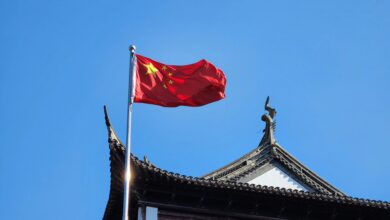China’s Q1 2025 GDP Expands 5.4% Amid Trade Tensions and Domestic Challenges
BEIJING, April 16, 2025 (WE)— China’s economy has shown resilience in the first quarter of 2025, with the nation’s Gross Domestic Product (GDP) expanding by 5.4% year-on-year, according to data released by the National Bureau of Statistics (NBS). This growth rate surpasses analysts’ expectations and aligns with the government’s annual growth target of “around 5%” .
Economic Performance Overview
The GDP reached 31.88 trillion yuan (approximately $4.35 trillion) in Q1 2025. On a quarter-on-quarter basis, the economy grew by 1.2%, indicating a steady expansion .
Key economic indicators also demonstrated positive momentum:
- Industrial Output: Value-added industrial output increased by 7.7% year-on-year in March, up from 5.9% in the first two months of the year .
- Retail Sales: Consumer goods retail sales rose by 5.9% year-on-year in March, accelerating from 4% in January-February .
- Fixed-Asset Investment: Investment in fixed assets grew by 4.2% year-on-year in Q1, slightly up from 4.1% in the first two months .
Despite these positive figures, the NBS cautioned about external uncertainties and weak domestic demand, noting that the foundation for sustained recovery has yet to be fully established .
Trade Dynamics
Foreign trade played a significant role in the economic performance. China’s exports increased by 6.9% year-on-year in Q1, reaching RMB 6.1 trillion (approximately $834.4 billion), while imports fell by 6% to RMB 4.2 trillion ($567.5 billion). The decline in imports reflects subdued domestic demand .
However, the trade surplus is under pressure due to escalating trade tensions with the United States. The U.S. has imposed tariffs of up to 145% on Chinese goods, prompting retaliatory measures from Beijing .
Domestic Policy Measures
In response to these challenges, the Chinese government has implemented several policies to stimulate domestic demand:
- Fiscal Stimulus: Increased government spending and tax cuts aimed at boosting consumption and investment.
- Monetary Policy: Adjustments in interest rates and reserve requirements to encourage lending and economic activity.
- Sectoral Support: Targeted assistance to key industries, including technology and manufacturing, to enhance competitiveness.
These measures are designed to mitigate the impact of external pressures and support sustainable economic growth.
Outlook and Risks
While the Q1 performance is promising, analysts express caution about the sustainability of this growth. The ongoing trade war with the U.S. poses significant risks, with potential for further tariff increases and supply chain disruptions. Additionally, structural issues such as demographic challenges and environmental concerns may affect long-term economic stability .
In conclusion, China’s economy has made a strong start in 2025, demonstrating resilience amid external and internal challenges. Continued policy support and strategic adjustments will be crucial in maintaining growth momentum throughout the year.
Read More:
- Tesla Shares Soar to Record High on Post-Election Momentum
- What to Know About Tax Years 2024 and 2025: Key Changes and Brackets
- Amazon Workers Strike Across Multiple Sites Amid Union Push for Labor Contract
![Xi Jinping meets Cambodia’s PM Hun Manet at Peace Palace, Phnom Penh – April 17, 2025 [AKP/Reuters]](https://theworldseye.com/wp-content/uploads/2025/04/2025-04-17T120007Z_1791565247_RC2NZDAP58BL_RTRMADP_3_CHINA-SOUTHEAST-ASIA-CAMBODIA-1744896414-390x220.jpg)














